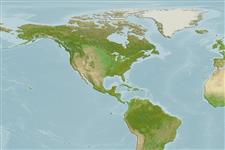Malacostraca |
Decapoda |
Palinuridae
Environment: milieu / climate zone / depth range / distribution range
Ecology
Benthic; depth range 0 - 40 m (Ref. 96667). Subtropical; 23°S - 30°S, 133°W - 109°W (Ref. 4)
Pacific Ocean.
Length at first maturity / Size / Weight / Age
Maturity: Lm ? range ? - ? cm Max length : 25.0 cm TL male/unsexed; (Ref. 101422); common length :24 cm BL (female)
It has lengths of 15 to 25 cm (male) and 15 to 24 cm (female) total body length; 6 to 10 cm (male) and 6 to 9.5 cm (female), carapace length (Ref. 4). Littoral to sublittoral (Ref. 77016). Found in shallow water, from 1 to 5 m deep in crevices of rocky substrates (Ref. 4). Nocturnal. Omnivorous. In general, thorny lobsters have a consistent diet of gastropods, fish remains, decapod, red algae, and brown algae (Ref. 107049).
Life cycle and mating behavior
Maturity | Reproduction | Spawning | Eggs | Fecundity | Larvae
Impregnated and ovigerous females have been taken in December (Ref. 4).
Holthuis, L.B. 1991 FAO Species Catalogue. Vol. 13. Marine lobsters of the world. An annotated and illustrated catalogue of species of interest to fisheries known to date. FAO Fish. Synop. 125(13):292p. Rome: FAO. (Ref. 4)
IUCN Red List Status
(Ref. 130435: Version 2025-1)
CITES status (Ref. 108899)
Not Evaluated
Not Evaluated
Threat to humans
Human uses
Fisheries: commercial
| FishSource |
Tools
More information
Population dynamicsGrowthMax. ages / sizesLength-weight rel.Length-length rel.Length-frequenciesMass conversionAbundance Life cycleReproductionMaturityFecunditySpawningEggsEgg developmentLarvae PhysiologyOxygen consumption
Human RelatedStamps, coins, misc.
Internet sources
Estimates based on models
Fishing Vulnerability
Low vulnerability (15 of 100).
